Scratch Funny Funnel Original Design / Scratch Built
Scratch - Funny Funnel {Scratch}
Contributed by Jeff Boldig
| Manufacturer: | Scratch |
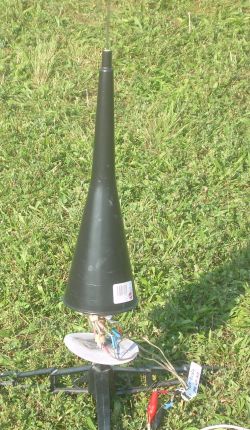
Brief:
Oil funnel with a 4 x 18mm cluster and a central tube that works as a launch lug. The motors are canted at 10° to
induce spin which begins before leaving the rod. The base drag is insufficient to stabilize the rocket so it is spin
stabilized.
Construction:
The body is an oil funnel available at Wal-Mart stores. A small wooden plug is in the end of the funnel and a
aluminum tube runs the full length. A 3" motor assembly tube was glued in the funnel with a forward bulkhead. An
aft centering ring was cut into quarters and two quarters were attached to the aft end of the motor assembly tube. The
forward bulkhead holds and centers the aluminum launch lug and the two aft centering ring pieces provide two recovery
storage compartments for shock cord and parachute. A motor mount assembly was made with a tube that fit into the motor
assembly tube. Four motor mount tubes were cut and engine block installed so the motors would extend 1/4 to 1/2 inch
out of the tubes. Two bulkheads with 10° holes for the motor tubes were installed in the motor mount assembly along
with the four motor mount tubes. There was also a central tube inside the motor mount assembly that slides over the
central launch lug and seals ejection gases from getting inside the motor mount assembly.
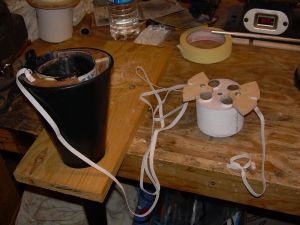
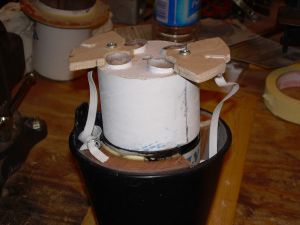
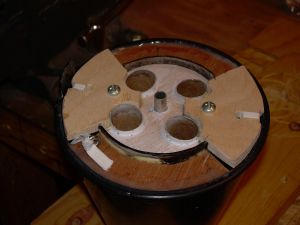 The motor assembly tube is notched on each side at angles that match the recovery
compartments. Two compartment covers were shaped and attached to the motor mount assembly. These cover the recovery
storage compartments to prevent early deployment and also fit into the notches in the motor assembly tube to allow the
motor mount assembly to induce spin on the rocket without slipping or spinning inside the motor assembly tube.
The motor assembly tube is notched on each side at angles that match the recovery
compartments. Two compartment covers were shaped and attached to the motor mount assembly. These cover the recovery
storage compartments to prevent early deployment and also fit into the notches in the motor assembly tube to allow the
motor mount assembly to induce spin on the rocket without slipping or spinning inside the motor assembly tube.Six feet of 1/4 elastic shock cord is connected from one recovery compartment cover to a screw eye installed in the aft centering ring. A 6 inch piece of Kevlar® is attached to the other recovery compartment cover and a loop is put in the free end. The parachute is attached to the Kevlar® cord and stowed in the recovery compartment.
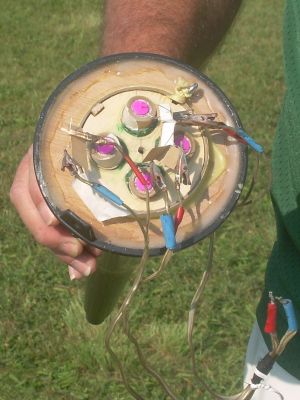
Flight and Recovery:
The first two flights were unsuccessful. The up worked fine. The funnel flew straight. There was no parachute
deployment on either flight and the second one landed on the corner of a concrete slab and shattered the funnel.
Another funnel was obtained and rebuilt with the current configuration.
The third flight (first on new funnel) flew OK, but was not as stable as the first version, probably because of a heavier aft end and only three motors igniting. The motor mount assembly ejected from the funnel but because elastic shock cord was used to attach to the parachute, the elastic stretched out and expended all of the momentum of the motor mount assembly without pulling the chute from the recovery compartment.
The fourth flight had all four motors ignite and was more stable than flight three but not as stable as the first two. It flew to about 300ft. The Kevlar® connected to the parachute didn't stretch and the chute was pulled from the storage compartment and recovery was successful.
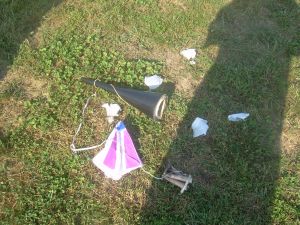
Summary:
This is a fun and different oddroc. It still needs some refinements but is a stable and fun flier. The cons are
typical of four engine clusters. The igniter installation and connection is critical to getting all the motors to
light. The recovery storage compartments are smaller then I would like, forcing the use of a smaller then optimal
chute.
Sponsored Ads
 |
 |











